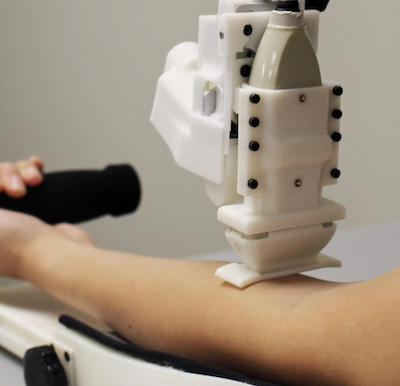
Robot draws blood as well as healthcare workers
By DE Staff
Automation MedicalFirst clinical trial of automated blood drawing and testing device attains 87% success rate.

A prototype of an automated blood drawing and testing device developed at Rutgers University. (Photo credit: Unnati Chauhan)
During the trial, the robot achieved an overall success rate of 87% for the 31 participants whose blood was drawn, which is comparable to or better than clinical standards. For the 25 people whose veins were easy to access, the success rate was 97%.
In addition to an ultrasound image-guided robot that draws blood, the device also includes a module for handling samples and a centrifuge-based blood analyzer. According to its developers, the device could be used at bedsides and in ambulances, emergency rooms, clinics, doctors’ offices and hospitals.
“A device like ours could help clinicians get blood samples quickly, safely and reliably, preventing unnecessary complications and pain in patients from multiple needle insertion attempts,” said lead author Josh Leipheimer, a biomedical engineering doctoral student in the Yarmush lab in the biomedical engineering department in the School of Engineering at Rutgers University-New Brunswick.
Inserting a needle into a vein to get a blood sample or perform IV therapy, known as venipuncture, is the world’s most common clinical procedure, with more than 1.4 billion performed yearly in the US alone. However, clinicians fail in 27% of patients without visible veins, 40% of patients without palpable veins and 60% of emaciated patients, according to previous studies.
Repeated failures to start an IV line boost the likelihood of phlebitis, thrombosis and infections, and may require targeting large veins in the body or arteries – at much greater cost and risk. As a result, venipuncture is among the leading causes of injury to patients and clinicians.
In the future, the Rutger’s team says the device could be used other procedures like IV catheterization, central venous access, dialysis and placing arterial lines. The team says next steps will include improve success rates in patients with difficult veins to access and using data from this study to enhance the robot’s AI to improve its performance.
www.rutgers.edu
